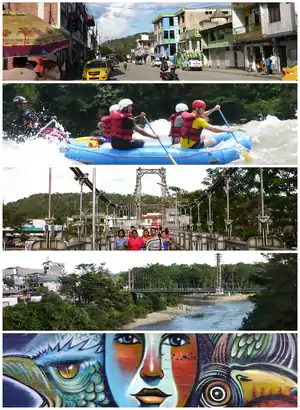Tena, Ecuador
Tena (Spanish pronunciation: [ˈtena]), the capital of the Napo Province, is a city in the Amazon rainforest. Known as the “cinnamon capital" of Ecuador, and founded by missionary explorers, Tena has emerged as a major commercial center of Ecuador. It is home to a regional hospital and many tourist related businesses, including a small airport and a vital bus terminal.
Tena | |
|---|---|
 | |
 Flag | |
| Nickname(s): Cinnamon Capital | |
 Tena Location of Tena in Ecuador | |
| Coordinates: 0.9890°S 77.8159°W | |
| Country | |
| Province | Napo |
| Canton | Tena |
| Founded | 1560 |
| Government | |
| Area | |
| • City | 261.84 km2 (101.10 sq mi) |
| Elevation | 598 m (1,962 ft) |
| Population | |
| • City | 33,934 [1] |
| • Metro | 60,880 |
| Demonym(s) | Tenese / Tenense (spanish) |
| Time zone | UTC-5 (ECT) |
| Area code(s) | (+593) 6 |
| Climate | Af |
| Website | www.tena.gob.ec (in Spanish) |
Geography
At the confluence of the Tena and Pano rivers in the center of town lies a popular pedestrian bridge, "el puente peatonal". The rivers become the Tena River, which soon joins with the Misahualli and eventually flows into the Napo River. The Napo winds its way south into Peru, and is in effect the 9th largest tributary to the Amazon River.
Climate
Tena is located in the rainforest, 420m above sea level. There is rainfall year-round, with an annual average of 171.65 inches (4,359.91 mm). The heaviest rains come in April, May, and June.
Tourism
Tena is a popular launching point for jungle, kayaking and rafting tours in Ecuador's Amazon rainforest region. The entry to the city is marked by a statue of the indigenous hero Jumandy, who led an uprising against the Spanish colonizers in 1578 and was subsequently executed.
The town is popular with tourists. Many inexpensive hotels, tourist agencies, and restaurants cater to backpacker tourism since the town in a launch point for trips into the rainforest. Tena is surrounded by forested hills and is located at the edge of the Andes, which are visible to the west.
Tena and its surrounding indigenous communities are also bases for many volunteers working for reforestation projects, with community support in development initiatives in diverse, and connected areas such as, ecotourism and capacity building. The indigenous populations of Ecuador are some of the most politically organized in Latin America, and Tena houses two major confederations, Fenakin (Federación de Organizaciones de la Nacionalidad Kichwa de Napo) and Ashin (Asociación de Shamanes Indígenas de Napo); one of the major stand-offs during the 2001 indigenous uprising in Ecuador, took place here.
Oil prospecting is a point of contention here, as there is drilling of the 250-square-mile (650 km2) Pungarayacu heavy oil field by Canadian corporation Ivanhoe.
Transportation
Most roads in the Oriente are unpaved and subject to landslides and other delays, especially during the rainy season. The road from Quito to Tena, however, is fully paved as of 2012, and it includes a spectacular passage over Papallacta Pass, above 4,000 m elevation. There is regular bus service over this road to Tena via Baeza. Small yellow truck-taxis are abundant in the city.
Around the time of the discovery of oil in the province, Mayor Galo de la Torre Airport was constructed to serve Tena. It closed in 2001. A new airport, Jumandy Airport located 27 km (17 mi) to the east near Ahuano, was inaugurated in 2011. The only airline that served it, TAME, ended flights to Tena in January 2016 citing low passenger loads.
Recreation
Tena is famous for the rainforest and rivers that surround it. It has some of the best rafting and kayaking in Ecuador. The jungle rivers on the Amazon side of the Andes are bigger and have more consistent flows than their west-Andean counterparts.
See also
- Sumaco Volcano - is located in the isolated Sumaco Napo-Galeras National Park and it is easily one of the most intense experiences to be had in Ecuador. The volcano soars 3732 metres above the jungle and is surrounded by precipitous ravines and dense jungle, which have largely kept humans out and preserved its flora and fauna. You need a guide to reach Sumaco. Guides can be found in the villages along the Loreto Road, which meets the Tena-Quito road approximately 30 kilometres north of Tena.
- Jatun Sacha Biological Station The station is continually conducting rainforest research and, as the second largest conservation organization in Ecuador, is involved in an array of sustainable development and forest protection projects.
- Misahuallí - is a bustling and somewhat remote port at the juncture of the rivers Napo and Misahuallí. The village was the original Ecuadorian jungle tourist outpost, and after dozens of years and despite the entrance of Tena and other jungle towns into the tourism market, is still a popular starting point for jungle tours and canoe trips.
- Cuevas de Jumandy - four kilometres north of Archidona on the road to Quito is a labyrinth of natural caves and tunnels that extend several kilometres underground.
- Archidona - a colonial town, founded in 1560, north of Tena, Archidona still serves as one of the region's main missionary outposts. It's also a business and social center for the small Quichua communities in its vicinity.
- Birdwatching - The rainforest is one of the best options for bird lovers, and the Ecuadorian Amazon is among the most biodiverse places in the world.
See also
Gallery
 Tena (2011)
Tena (2011).jpg.webp) Tena Main street (2009)
Tena Main street (2009).jpg.webp) Local children
Local children.jpg.webp) Street in Tena (2009)
Street in Tena (2009).jpg.webp) Child with dog
Child with dog.jpg.webp) Tena street (2009)
Tena street (2009)
